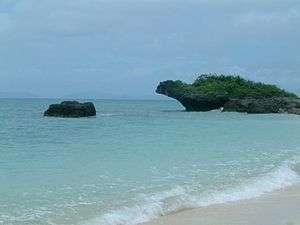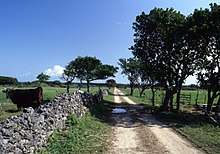Kuro
Kuro Island (黒島 Kuroshima), often referred to by its full Japanese name Kuroshima, is one of the smaller of the Yaeyama Islands of Japan.

- For the Kuroshima near Kagoshima, Kyushu, see Mishima Islands.
Understand
This island is famous for cattle and there are about 3000 cows in this island in spite of the fact that there are only 200 people. This island is completely away from modern life. for example, there are no convenience stores, no DVD rental stores, no signal on the street, etc. There is just one very small general store and a few cafes. What the island does have is a beautiful beach, arguably more beautiful than those on Okinawa Island, as well as some pretty good snorkeling. Plus, as there are few people on the beach, and it will be rather private.
Get in
By boat
There are five to six daily departures from Ishigaki, depending on the season, and the travel time is about 25 minutes.
Get around
Bicycles are the recommended way of getting around the island, letting you get from one side to the other in less than half an hour. Bicycles and motorbikes can be rented at the port. Walking is possible, but takes a lot longer.
See

- Nishi no Hama (西の浜) (just west of the port). Not much in the way of a beach, but it's a spawning ground for sea turtles during summer nights. The turtles are a protected species, of course, so viewing them is possible only under strictly regulated conditions.
- The small Kuroshima Research Station (黒島研究所). Studies mostly sea turtles, and plenty of juvenile specimens can be viewed in tanks. There's also a fearsome coconut crab in a cage, as well as coral and shells on display. Entry is ¥300. Nighttime excursions to view the sea turtles are available for ¥1500.
- Iko Pier (on the north coast of the island). You can walk far out over the beautiful blue lagoon, with views of Iriomote across the water.
- Cows. Everywhere. Cows. (Maybe impressive if you've spent your whole life in a big city, not so much if you've ever lived in the countryside.)
Do
- Nakamoto Beach (仲本海岸). Doesn't have turtles, but the reef is a quite good snorkeling spot. It seems to only be officially open for swimming during low tide, when the lagoon becomes completely separated from the sea. During other times there can be strong currents, so be careful.
Buy
There is one very small general goods store with a small selection of snacks and produce, located at the north end of the village in the middle of the island. You can find it labeled on some of the tourist maps as just "Store". Locals take the ferry to Ishagaki to do most of their shopping.
Eat and drink
There are at least a couple small cafes scattered around the island, but not many. You will probably come across one if you're cycling around.
Sleep
- Shimajuku Nankuru (しま宿南来). Lodging with 2 meals, ¥5500.
- Nakataso (なかた荘), Kuroshima 31. Minshuku with a surprisingly modern building (opened in 2003). ¥4000 for a private Japanese-style room, +¥500 for breakfast, +¥1500 for dinner, +¥500 for a Western-style room. -¥500 if you stay for 3 days or more and take both meals. A/C is ¥100 for 90 min; wifi, transportation to/from the harbor, and awamori (up to a point) are free.
Go next
Unless you have your own boat, the only place to go from here is back to Ishigaki!